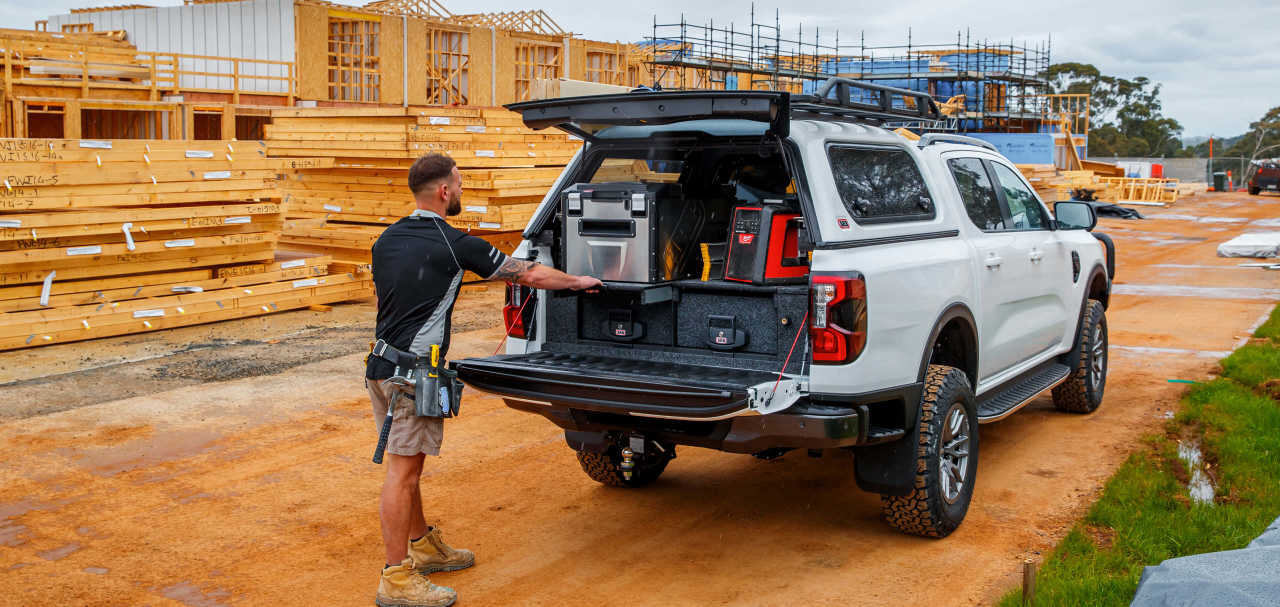The 4x4 dual-cab ute is the most popular and versatile light commercial vehicle in the Australian automotive market, due to its proven ability to serve as both a work truck and/or family hack during the week and escape machine on the weekend.
However, not everyone needs high-riding off-road ability and we’d wager those that don't would be happy to trade that for more spacious rear seating and a large fully-enclosed cargo bay to carry their team and their gear – be it work or play.
It’s those two key attributes which present a compelling argument in favour of what’s known as a crew van. This is effectively a mid-sized commercial van (2.5-3.5 tonne GVM) fitted with a second row of seats, which can increase the seating capacity to five – or in some models - six occupants.
After a week of testing, we discovered that Toyota’s HiAce-based version is worthy of consideration as a tradie’s genuine alternative to a dual-cab ute.
Toyota HiAce 2020: LWB Crew Interior Pack
| Engine Type | Diesel Turbo 4, 2.8L |
|---|---|
| Fuel Type | Diesel |
| Fuel Efficiency | 8.2L/100km (combined) |
| Seating | 5 |
| Price From | $30,800 - $37,070 |
| Safety Rating |
|
Price and Features – Does it represent good value for the price? What features does it come with?
Our test vehicle is the long wheelbase (LWB) Crew Van, which is available only with a 2.8 litre turbo-diesel engine and six-speed torque converter automatic transmission for a list price of $47,140.
That figure slots in between the Hyundai iLoad Crew auto at $44,290 and Ford’s Transit Custom 340L LWB DCiV (Dual Cab in Van) at $49,990.
.jpg)
The HiAce Crew Van offers a colour choice between the ubiquitous French Vanilla (white) and metallic grey Quicksilver as seen on our test vehicle. This more upmarket look is enhanced with body-coloured front and rear bumpers, door handles and door mirrors, front fog lights and a digital rear-view mirror with auto-dimming.
There’s no fancy alloys though; just the usual 16-inch steel wheels with plastic wheel covers, 215/70R16 tyres and a full-size spare carried under the tail.
.jpg)
You also get opening windows in the sliding side doors, plus standard features common to all HiAce vans like a leather-accented steering wheel with height-and-reach adjustment, cruise control, 4.2-inch driver’s multi-information display (MID) and more.
There’s also a well-appointed multimedia system with steering wheel controls and a big 7.0-inch central touchscreen, controlling AM/FM radio (no DAB+ digital), multiple inputs for CD/USB/AUX/ Bluetooth plus Apple CarPlay/Android Auto.
.jpg)
Design – is there anything interesting about its design?
The second row is a bench seat with 60/40 split-fold backrests which can be reclined separately. Or if you’re not carrying passengers, they can rotate forward through 90 degrees to lay flat on top of the base cushion if more cargo volume is required, or perhaps longer items need to be carried (with no cargo barrier fitted of course).
The three-piece windows in the side sliding doors have centre panes which slide backwards and lock into position, leaving about one third of the total glass area open to let the breeze in.
.jpg)
The rear seating area has a spacious and airy feel, even for tall adults, with plenty of headroom. There’s also generous leg room with ample space for three passengers to rest their feet, thanks to the HiAce’s wide and flat load floor which is devoid of the usual transmission hump that intrudes into the rear floor space of most dual-cab utes.
There’s also ample space between the ends of the bench seat and the sliding doors on each side, allowing more shoulder room for three than you’ll ever find in the back seat of a dual-cab ute.
Engine and transmission – What are the key stats for the engine and transmission?
The Euro 5-compliant 1GD-FTV 2.8 litre four-cylinder turbo-diesel, which is shared with the current HiLux, Prado and Fortuner, produces 130kW at 3400rpm and in automatic models like our test vehicle, a sizeable 450Nm of torque between 1600-2400rpm.
.jpg)
The Aisin AC60E six-speed torque converter automatic has full converter lock-up on fourth, fifth and sixth gears, along with overdrive on fifth and sixth for economical highway driving and the option of sequential manual-shifting. The 3.727:1 rear axle is equipped with an electronic auto-LSD.
Fuel consumption – How much fuel does it consume?
Toyota’s official combined figure of 8.4L/100km was not far off our own figure of 10.1 calculated from fuel bowser and trip-meter readings. This was after 407km of testing which included more than 120km with a near-maximum payload. We also had the annoying auto stop-start function switched off. So, based on our figures, you could expect a ‘real world’ driving range of around 700km from its 70-litre tank.
Practicality – How practical is the space inside?
The Crew’s 2305kg kerb weight and 3300kg GVM results in a near one-tonne payload of 995kg. That sounds great, but keep in mind that a team of five big blokes could use up at least half of that payload capacity before you start loading any of their gear on board.
The Crew’s also rated to tow up to 1500kg of braked trailer and with a 4800kg GCM (or how much it can legally carry and tow at the same) it can tow that weight without any reduction in payload required. That's very practical.
The standard LWB HiAce’s cargo bay dimensions are 2530mm length, 1760mm width and 1340mm height, with 1268mm between the rear wheel housings and total load volume of 6.2 cubic metres.
Unfortunately, Toyota does not publish official dimensions or load volume for the Crew Van’s smaller cargo bay, so by our guesstimates it’s roughly half the length with roughly half the load volume of the standard LWB HiAce.
.jpg)
So that’s about 3.0 cubic metres or more, which still dwarfs most dual-cab utes fitted with hard canopies. The walls are also lined to mid-height and there’s four sturdy load anchorage points at floor height. However, due to the rear seat blocking access through the side doors, the cargo bay can only be accessed through the single-lift tailgate which is not forklift-friendly.
There’s also no standard load protection for occupants, so our best advice would be to install Toyota’s genuine accessory (or aftermarket) steel-mesh cargo barrier, which is designed to fit this rear position and therefore ideal for the Crew Van.
In terms of cabin storage options, there’s a big 1.5 litre bottle holder and storage bin in the base of each front door, with smaller 0.5 litre bottle/cup holders in the centre and on either side of the dash. There’s also a near-vertical A4-sized single glovebox, a small cubby to the left of the gearshift for small items like coins, chewy etc and an overhead glasses holder.
.jpg)
Unique to the Crew Van is a large open centre console, which sits low to the floor and looks like an oversized desk organiser with its three different-sized storage bins. This is very efficient in retaining bulky items like lunch boxes, Thermos flasks and clipboards plus small items like pens and things.
For rear passengers though, there’s no bottle holders or storage bins in the sliding doors and no flexible storage pockets on the front seat backrests. So the best solution here would be a pair of aftermarket cabin organisers fitted to the front seat backrests, to provide the storage of drink bottles and other items that the sliding doors can’t.
What’s it like as a daily driver?
The non-remote key fob, which requires manual locking and unlocking of the doors, feels out-of-step with such a modern vehicle. We also had to remove the centre headrest in the rear seat because it’s perfectly positioned to block most of the driver’s vision through the rear-view mirror. In fact, apart from a test drive with three rear seat passengers on board, the centre headrest remained in storage.
When empty or with light loads it has admirable ride quality for what is essentially a light commercial van. It can get a little jiggly on bumpy roads, which is not unexpected given the heavy live rear axle and suspension designed to cope with a GCM of almost 5.0 tonnes.
Engine response is excellent. With maximum torque on tap between 1600-2400rpm, the slick-shifting Aisin six-speed auto keeps the 2.8 litre turbo-diesel mostly within this 800rpm band of peak pulling power, which ensures immediate and energetic performance at all times.
The intelligent auto also responds when it detects driver braking on inclines by instantly downshifting a gear or two to assist with engine braking. The non-radar cruise control also maintains its set speeds with discipline.
Driving position is more like an SUV than a van with impressive comfort for a commercial vehicle; its large windscreen and front door windows provide clear eye-lines to the side mirrors.
With the centre rear headrest removed, there’s also unobstructed vision through the tailgate window while the side sliding door windows and blind-spot monitoring alleviate much of the driver’s usual blind-spots. In a nutshell, it’s quiet, refined, very manoeuvrable and easy to live with as a daily driver.
What’s it like for tradie use?
We loaded 770kg into the cargo bay, using a set of extended forklift tines that allowed rear access despite the single-lift tailgate. Combined with our crew of two up front, that equalled a payload of 970kg which just snuck in under the 995kg limit.
Although the bulk of this load was centred over the rear axle, the leaf-spring rear suspension only compressed 50mm leaving more than 40mm of bump-stop clearance for the rear axle and ample suspension travel.
You could barely detect this extra rear squat from the driver’s seat, as it floated over bumps and other road irregularities with great composure and not a hint of bottoming-out.
.jpg)
The drivetrain handled its near-maximum payload with ease on busy city and suburban roads and was equally at home on the highway, where it cruised within its peak torque zone with 1700rpm at 100km/h and 1800rpm at 110km/h.
It also easily cleared our 13 per cent gradient, 2.0km set climb at 60km/h, tapping into its ample 450Nm of torque to settle at 2400rpm in fourth gear all the way to the top. Engine braking on the way down was not as resolute, but not unexpected given the payload it was trying to restrain.
Despite its lack of storage options for rear seat passengers, the HiAce Crew ticks a lot of boxes in terms of practicality and versatility for a multitude of working roles, in which a team and their gear require spacious accommodation and competent operation.
Warranty & Safety Rating
Safety – What safety equipment is fitted? What safety rating?
Maximum five-star ANCAP rating and AEB with day/night pedestrian and day cyclist detection headline a long list of standard safety features, which along with Ford’s Transit Custom sets a mid-sized van benchmark to rival many passenger cars and SUVs.
There’s a total of nine airbags plus the latest driving aids including lane departure alert with steering assist, road sign assist, vehicle stability control including trailer sway control and hill-start assist, blind-spot monitoring, rear cross-traffic alert, reversing camera, front/rear parking sensors and more. There’s three full lap-sash seat-belts and headrests plus top-tether child seat anchorage points on the rear seat, but no ISOFIX fittings.
Ownership – What does it cost to own? What warranty is offered?
The HiAce is covered by Five years/unlimited kilometre warranty. Scheduled servicing every six months/10,000km whichever occurs first. Capped-price servicing of $240 covers the first four scheduled services over two years or up to 40,000km, whichever occurs first.
Verdict
If a big part of a 4x4 dual-cab ute’s appeal is its high-riding rugged appearance, it’s a shame a five-seater van like the HiAce Crew can’t duplicate that look because it would open many ute buyers’ eyes to the vastly superior rear passenger space and enclosed cargo capacity on offer.
It has its shortcomings, particularly the lack of rear seat cargo protection and storage options, but these can be addressed with genuine or aftermarket accessories. So if you need to carry a team and their gear in enclosed comfort for work or play, the HiAce Crew makes plenty of sense in either role.
Pricing Guides




.jpg)
.jpg)

.jpg)





.jpg)

.jpg)
.jpg)


.jpg)
.jpg)


.jpg)
.jpg)
Comments